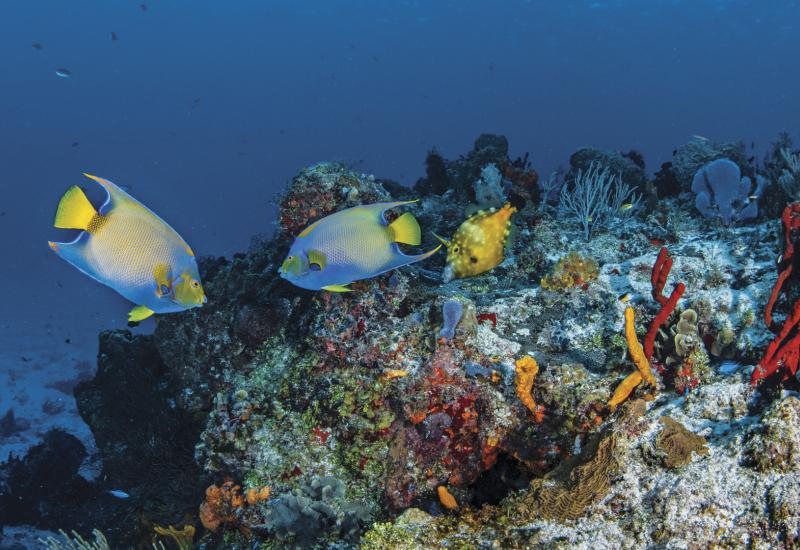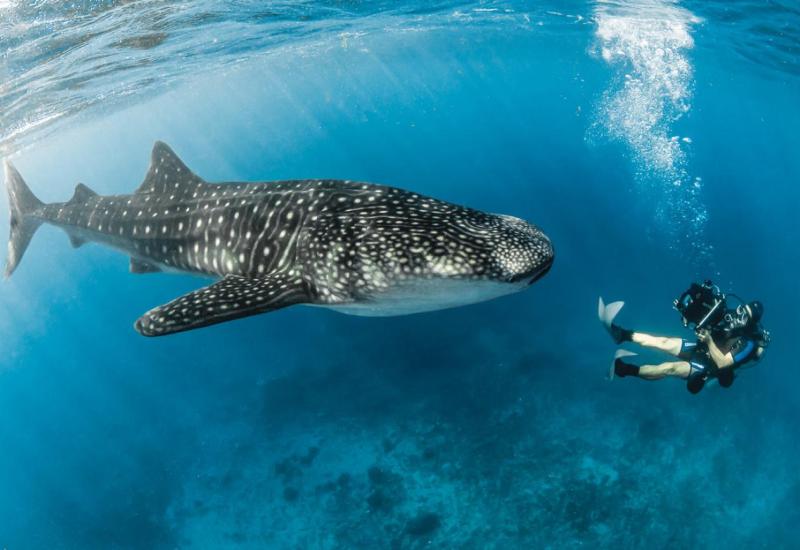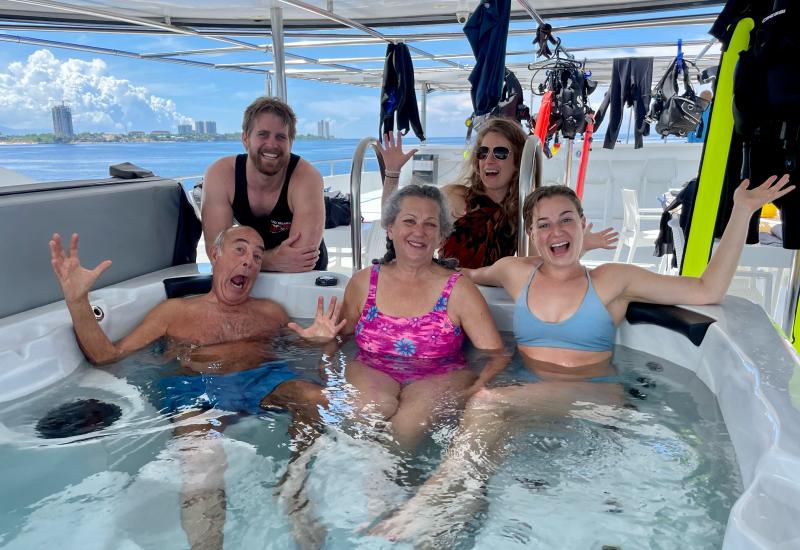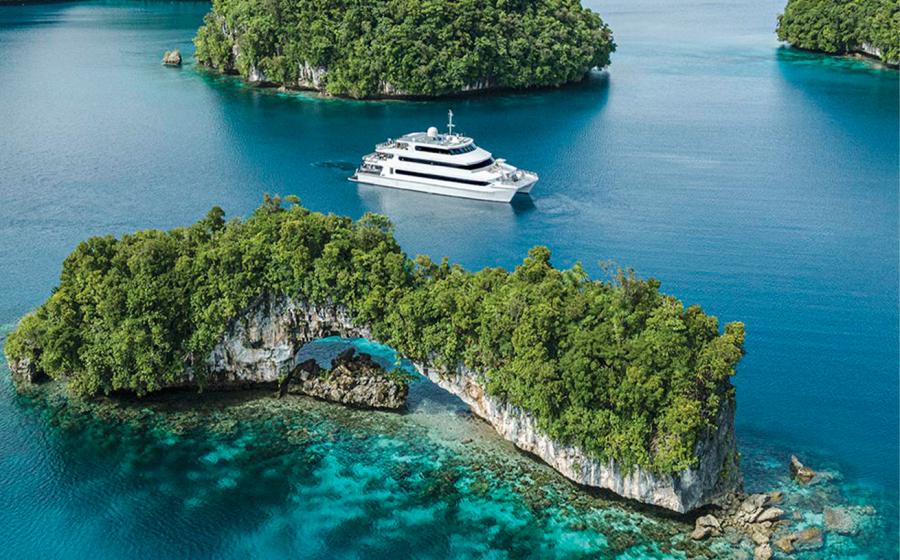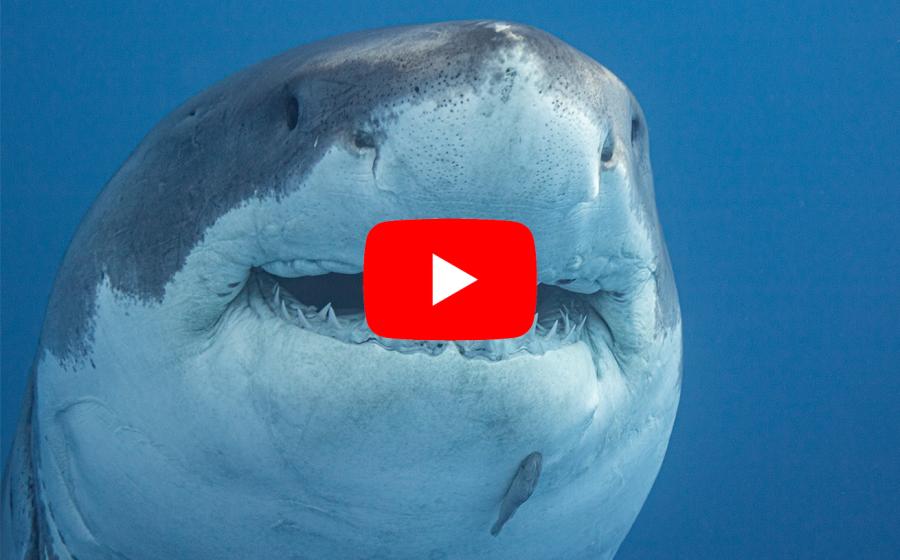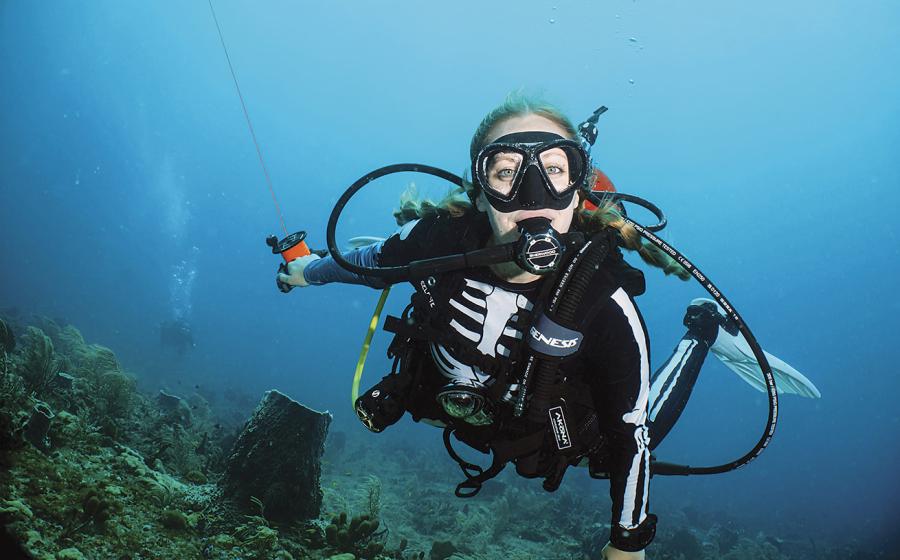A Taste of the Philippines: 23 Amazing Underwater Photos
I have been grooving on diving in Asia over the past eight or so years. From the West Coast where I live, getting to some of the prime dive areas in Asia requires about the same amount of travel time — and cost — as most destinations in the Caribbean, and once landed, most Asia Pacific destinations are quite budget-friendly. Planning ahead and possibly using frequent-flyer points for the long hauls means that this can be quite a reasonably priced commute.
The Tropical Pacific has a massive biodiversity. As a newcomer to this part of the world, I was blown away by how many new (to me) species I was spotting on each dive. Even now, after numerous trips, I can still look forward to seeing new stuff on most dives. The reefs tend to be colorful too — with an abundance of soft corals in some areas, and some truly spectacular hard-coral gardens. At most destinations, weird and wonderful muck diving is also on the menu.
Previous trips to this part of the world had taken me to Thailand and Indonesia — two countries with expansive dive regions and opportunities, only a fraction of which I have yet had the opportunity to dive. When a trip to the Philippines was organized by one of our regular dive-travel buddies, we jumped at the opportunity to try diving in these islands.
From Vancouver, Los Angeles, and other west coast major airline hubs, the logical routing is non-stop to Manila. From there, there are numerous, inexpensive regional flights servicing the many islands and regions of the beautiful archipelago of the Philippines. If it had not been for the unfortunate occurrence of a typhoon howling through Manila on the day before our arrival, which caused serious delays for all flights, our travel time from Vancouver to Dumaguete would have been impressively short.
A quick note about Manila’s International Airport — it is a bit of a gong show. Transferring between terminals generally involves a taxi ride, for which the lineups can be very long, and the taxis must go out into the snarl of city traffic to transfer passengers. It is highly recommended to leave yourself several hours should you need to change terminals at this airport.
When our short domestic flight landed in Dumaguete, we were greeted by a representative of Atlantis Dumaguete Resort, where we would spend the first of our two weeks diving in the Philippines
Atlantis Dumaguete is a great dive resort. Not super fancy, but with logical and efficient dive operations, good meals, great service, comfortable accommodations and a quiet beachfront location, it hits all the right notes. Competently managed, wonderful dive and resort staff, and an on-site wellness center (read: great massage) all contribute to a great dive trip experience.
The resort is located on a prime strip of muck-diving sites — some of which were as fruitful as the best of the muck-diving meccas I’ve dove in Indonesia. Blue Ring Octopuses and Flamboyant Cuttlefish were everywhere!
There is really not much reef diving anywhere near the resort (although a couple of artificial “tire reefs” are positively hopping with life), but they do run at least two excursions per week on their large boat to nearby Apo Island, where there is some very nice reef diving. Additionally, Atlantis Dumaguete also offer trips to snorkel with the whale sharks at Oslob, when they can wrangle a large enough group who wants to go.
The local diving is done from a small fleet of dive boats that the resort operates. Again, these are logically set up and are a comfortable platform from which to dive. Entry is via backroll and re-boarding is done via a ladder. Typically the boats go out for a single-tank dive, and return for refills, refreshments, quick camera recharges and potty breaks. Four boat dives are offered per day, as well as shore (muck) diving. Air and Nitrox fills are available. Dive packages include both local boat-access muck diving and excursions to Apo Island for reef diving. I’d go back in a heartbeat …
Our second week was spent aboard the Atlantis Azores — part of the Atlantis group that currently has two dive resorts in the Philippines (Atlantis Puerto Galera being the other). The boat moves to different regions of the Philippines during the year, and so offers several itineraries. The beauty of our schedule was that the liveaboard picked us up and dropped us off at the resort, so transferring dive gear, cameras, baggage, etc., could not have been easier.
The Atlantis Azores is a spacious liveaboard dive vessel. The cabins are all reasonably appointed (each with an en-suite washroom), with the owners’ cabin being quite large and luxe. The main salon/dining area is as roomy as any boat I’ve been on. The food was exceptionally tasty, with meals offered both a la carte and served family style. The dive deck is well laid out with ample storage for each diver. Dive operations were as well organized as at the resort, and dives were lead by experienced dive guides. All dives are done from dinghies, and so involve back roll entry and a ladder to exit the water.
Our seven-day itinerary started with a morning at Oslob to snorkel with the whale sharks — which was the highlight of the trip for me. The story is that historically whale sharks have migrated through this region of the Philippines. Local fishermen used to capture and kill these gentle giants (whale sharks are filter feeders, so are not a threat to humans). At some point they realized that they could make more money by creating opportunities for tourists to swim with the sharks than by fishing them. These days, hundreds of people pay a park fee at Oslob, and then are dropped into the water for an hour or so interface with the sharks. It is a bit of a circus with so many people in the water at one time (and makes getting pleasing pictures challenging as well). The whale sharks are free to come and go, but they have been conditioned by the fishy handouts that the fishermen provide. Some might argue that the feeding of these sharks is changing their behavior (as an example, whale sharks are known to be highly migratory beasts, but these sharks appear to stick around for the free lunch). Personally, I’d rather see sharks conditioned to hand feeding than dead and de-finned …
Our trip then took us as far north as Sumilon Island, then to Cabilao Island, Panglao Island, and then a couple of days at beautiful (but touristy) Balicasag Island before our return to Dumaguete. This itinerary offered a good mix of pretty reef diving and a bit of muck, with the beautiful vertical terrain at Balicasag being the stand out location for reef diving.
I loved my first taste of the Philippines and would strongly recommend this destination. The relative ease of travel, budget-friendly dive options, great muck diving and pretty reefs, beautiful topside scenery, and wonderfully warm and generous Philippine people put this destination high on my all-time favorite dive destinations.
More of Judy G's Underwater Adventures:
Meet the Woman Behind the Lens | Oh, Baby! Juvenile Critters | How to Find Nemo
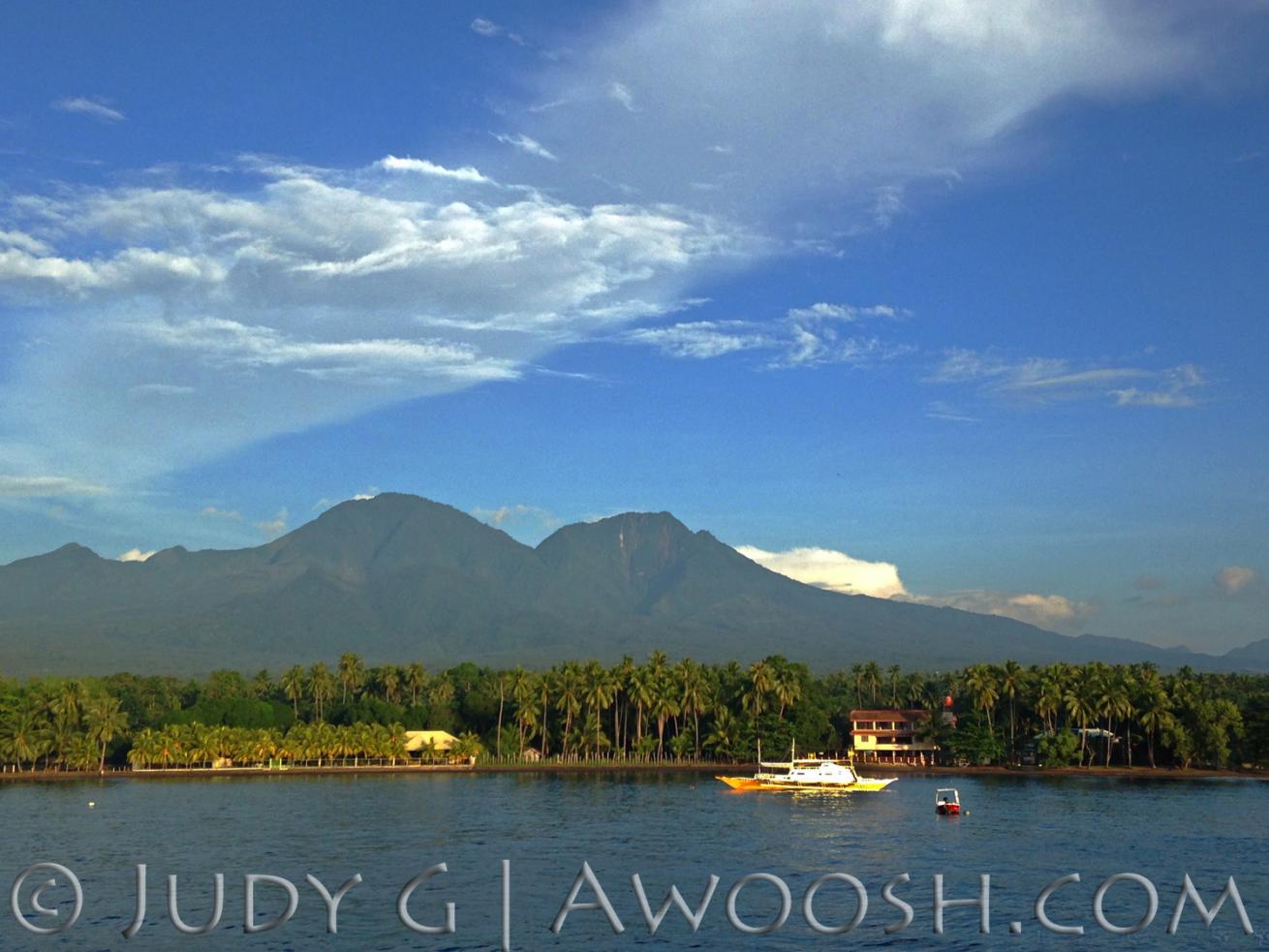
Judy GThis image is taken from the water, looking back towards Atlantis Dumaguete Resort. The Philippine islands are generally lush, green and are volcanic in origin.
I have been grooving on diving in Asia over the past eight or so years. From the West Coast where I live, getting to some of the prime dive areas in Asia requires about the same amount of travel time — and cost — as most destinations in the Caribbean, and once landed, most Asia Pacific destinations are quite budget-friendly. Planning ahead and possibly using frequent-flyer points for the long hauls means that this can be quite a reasonably priced commute.
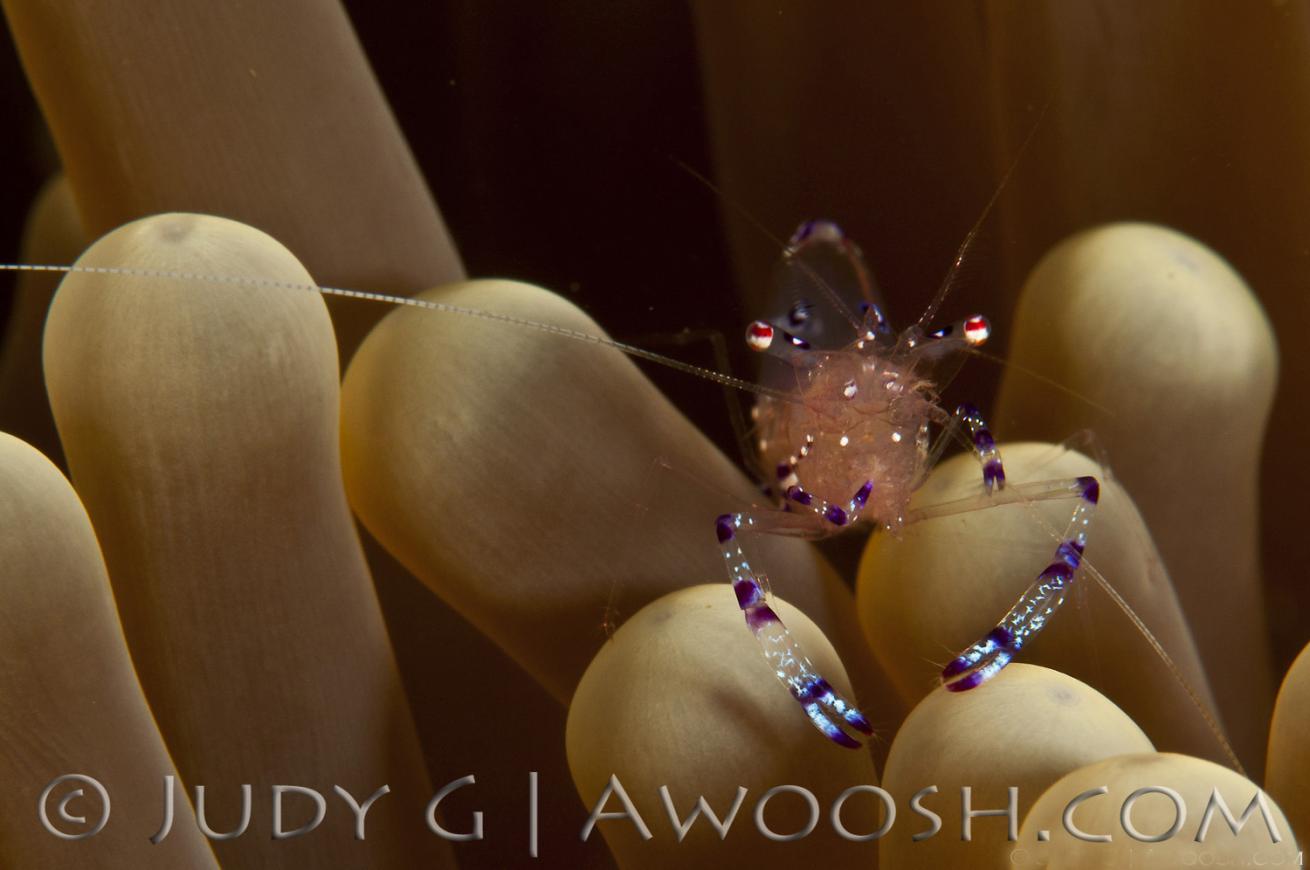
Judy GA Sarasvati Anemone Shrimp in the Philippines.
The Tropical Pacific has a massive biodiversity. As a newcomer to this part of the world, I was blown away by how many new (to me) species I was spotting on each dive. Even now, after numerous trips, I can still look forward to seeing new stuff on most dives. The reefs tend to be colorful too — with an abundance of soft corals in some areas, and some truly spectacular hard-coral gardens. At most destinations, weird and wonderful muck diving is also on the menu.
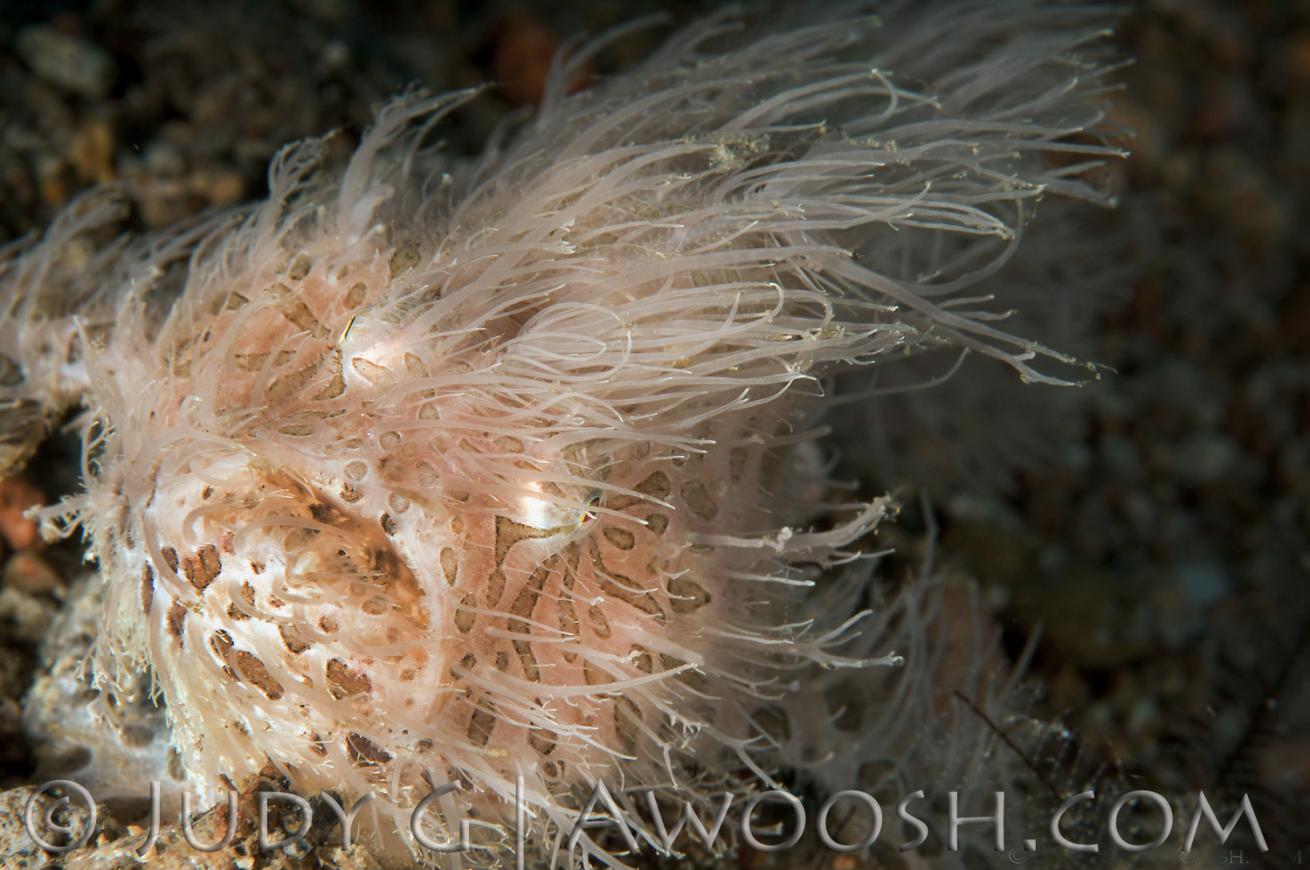
Judy GThis is a variation of the Striated Frogfish. Check out the "Cousin It" hair-do!
Previous trips to this part of the world had taken me to Thailand and Indonesia — two countries with expansive dive regions and opportunities, only a fraction of which I have yet had the opportunity to dive. When a trip to the Philippines was organized by one of our regular dive-travel buddies, we jumped at the opportunity to try diving in these islands.
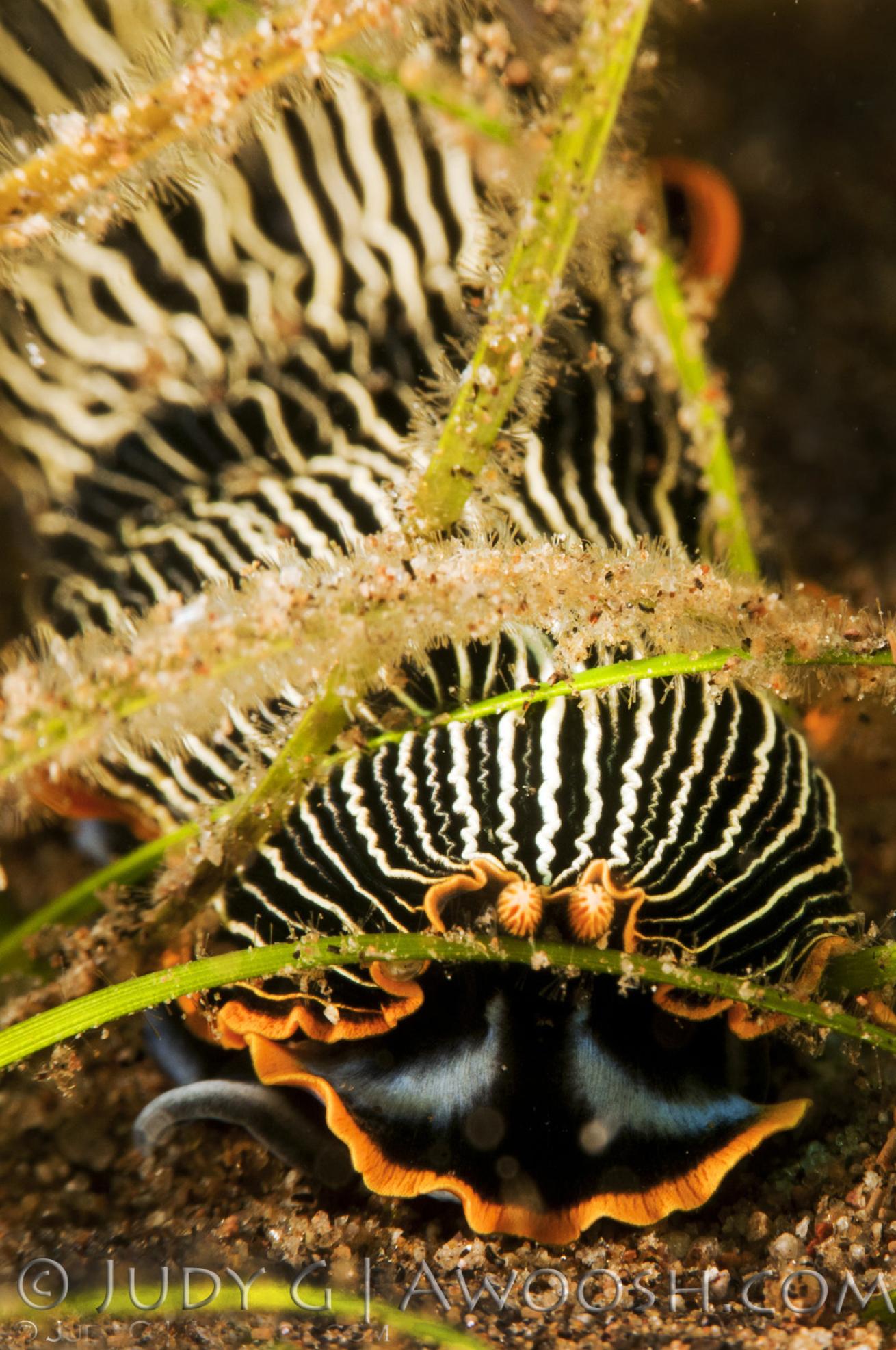
Judy GThe Philippines are known for their huge variety of nudibranchs. This Armina was just one of many that I spotted of this type, including many teensy juveniles. This sea slug was about an inch and a half long, and was traveling through some algae growing on some sand flats.
From Vancouver, Los Angeles, and other west coast major airline hubs, the logical routing is non-stop to Manila. From there, there are numerous, inexpensive regional flights servicing the many islands and regions of the beautiful archipelago of the Philippines. If it had not been for the unfortunate occurrence of a typhoon howling through Manila on the day before our arrival, which caused serious delays for all flights, our travel time from Vancouver to Dumaguete would have been impressively short.
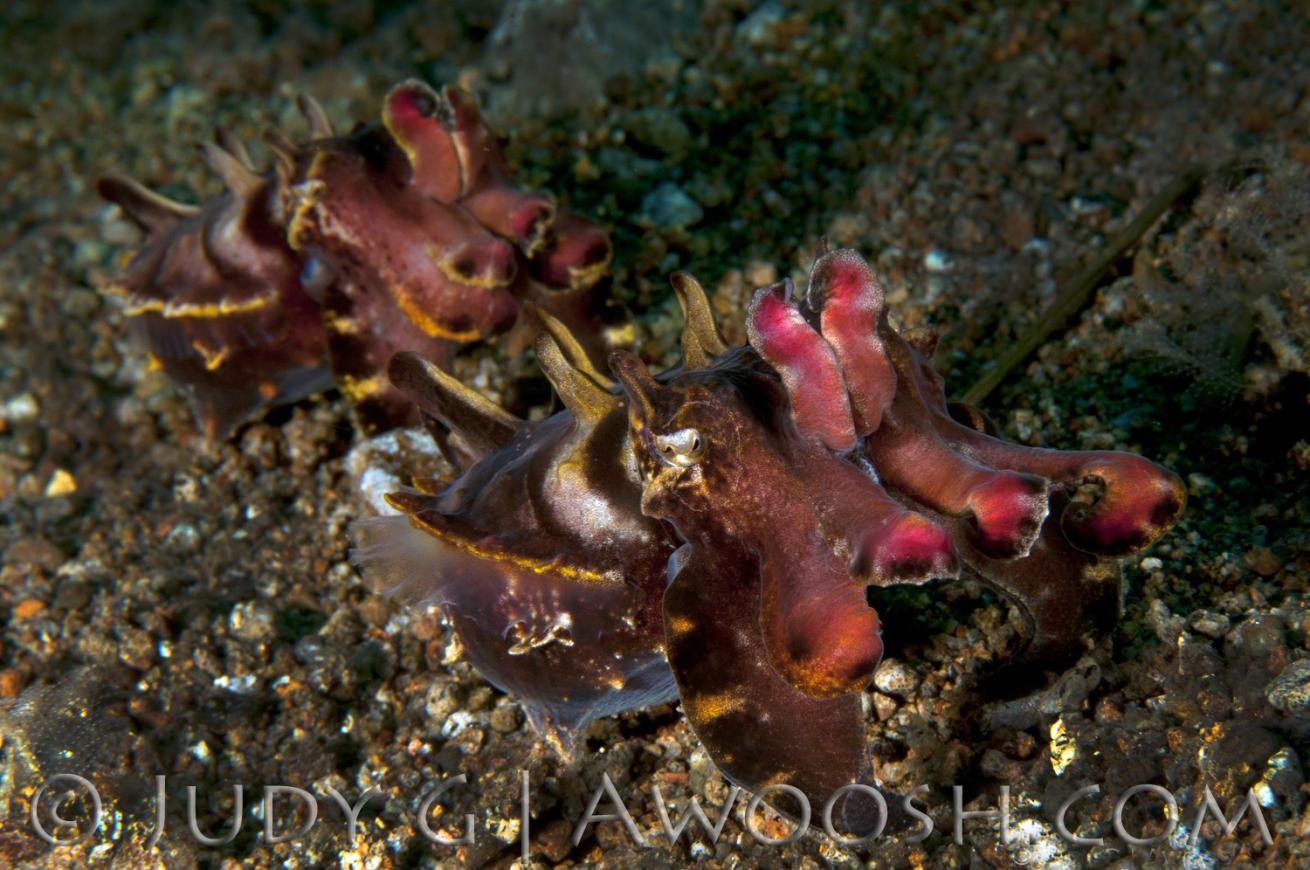
Judy GPrevious to this trip, I had only seen a couple of these gorgeous little cuttlefish in Ambon Bay, Indonesia. On one site near Atlantis resort, we spotted at least a half dozen of these on one dive! We were able to observe feeding behavior (they have a special tentacle with which they zap unsuspecting prey and bring it to their mouths). I also saw mating (super quick!), fighting, and I witnessed this — single file tailgating — quite a bit.
A quick note about Manila’s International Airport — it is a bit of a gong show. Transferring between terminals generally involves a taxi ride, for which the lineups can be very long, and the taxis must go out into the snarl of city traffic to transfer passengers. It is highly recommended to leave yourself several hours should you need to change terminals at this airport.
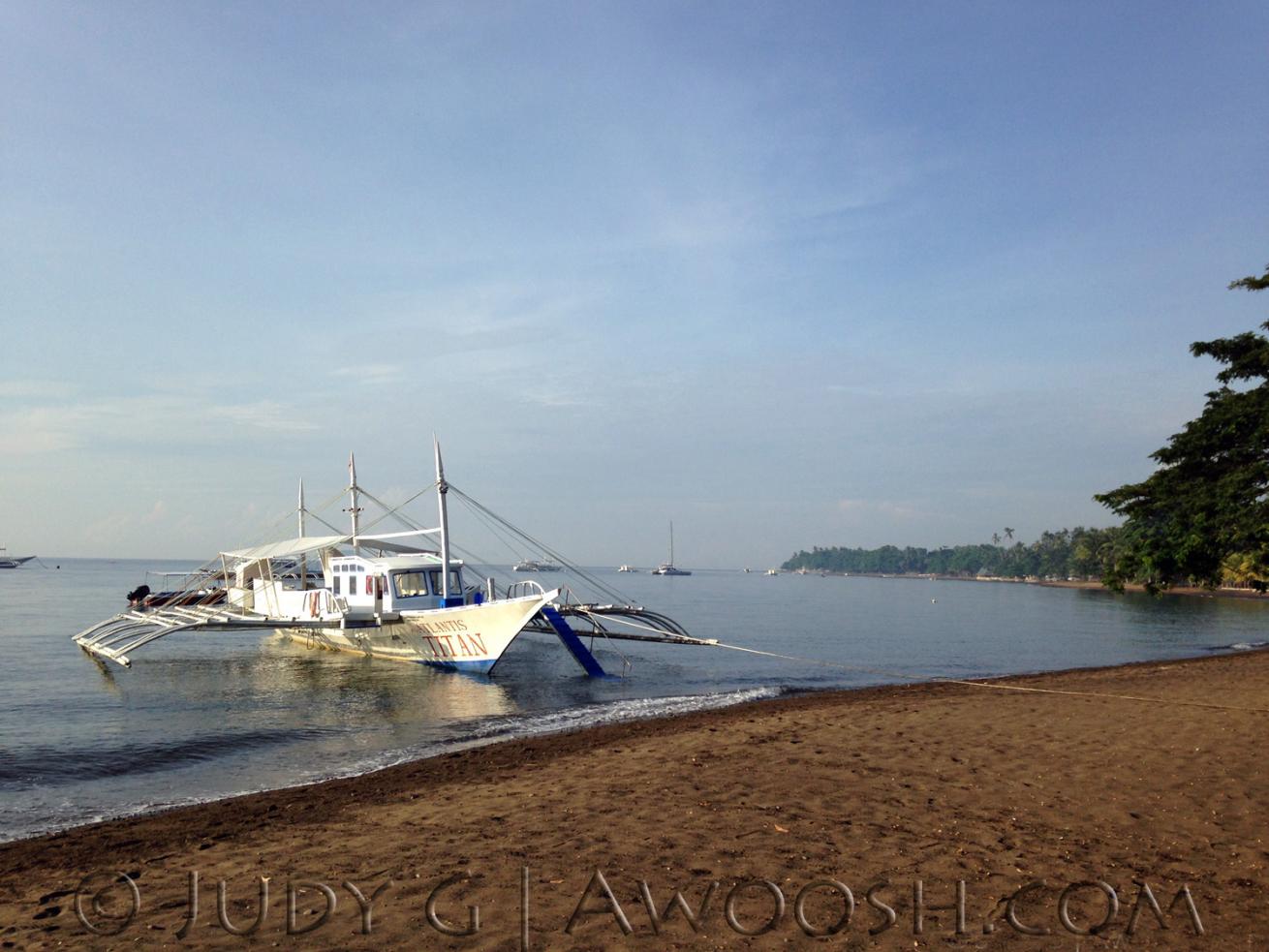
Judy GThis is the boat used by the resort for day trips to Apo Island for reef diving. It has washroom facilities and some dry storage available. For the Apo Island excursions, the resort packed delicious provisions, which the crew cooked for us. Hot lunch on a day boat — pretty awesome!
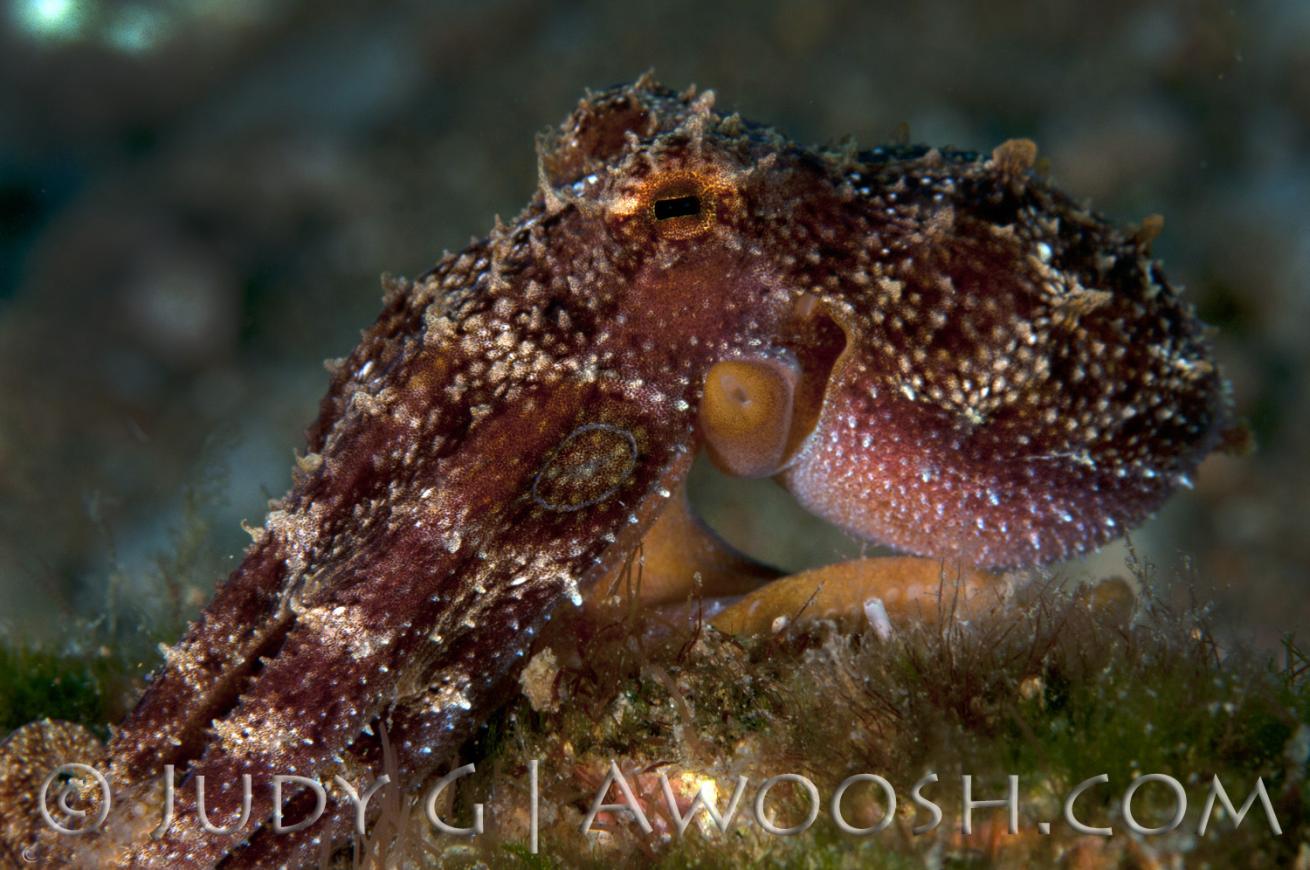
Judy GThis was an exciting sighting for me, as I had not seen this variety of octopus before. Like the Blue Ring octopus, this is a highly venomous creature. The single ring on each shoulder is the way to identify these creatures. This little octopus was about 3 inches in length.
When our short domestic flight landed in Dumaguete, we were greeted by a representative of Atlantis Dumaguete Resort, where we would spend the first of our two weeks diving in the Philippines
Atlantis Dumaguete is a great dive resort. Not super fancy, but with logical and efficient dive operations, good meals, great service, comfortable accommodations and a quiet beachfront location, it hits all the right notes. Competently managed, wonderful dive and resort staff, and an on-site wellness center (read: great massage) all contribute to a great dive trip experience.
The resort is located on a prime strip of muck-diving sites — some of which were as fruitful as the best of the muck-diving meccas I’ve dove in Indonesia. Blue Ring Octopuses and Flamboyant Cuttlefish were everywhere!
There is really not much reef diving anywhere near the resort (although a couple of artificial “tire reefs” are positively hopping with life), but they do run at least two excursions per week on their large boat to nearby Apo Island, where there is some very nice reef diving. Additionally, Atlantis Dumaguete also offer trips to snorkel with the whale sharks at Oslob, when they can wrangle a large enough group who wants to go.
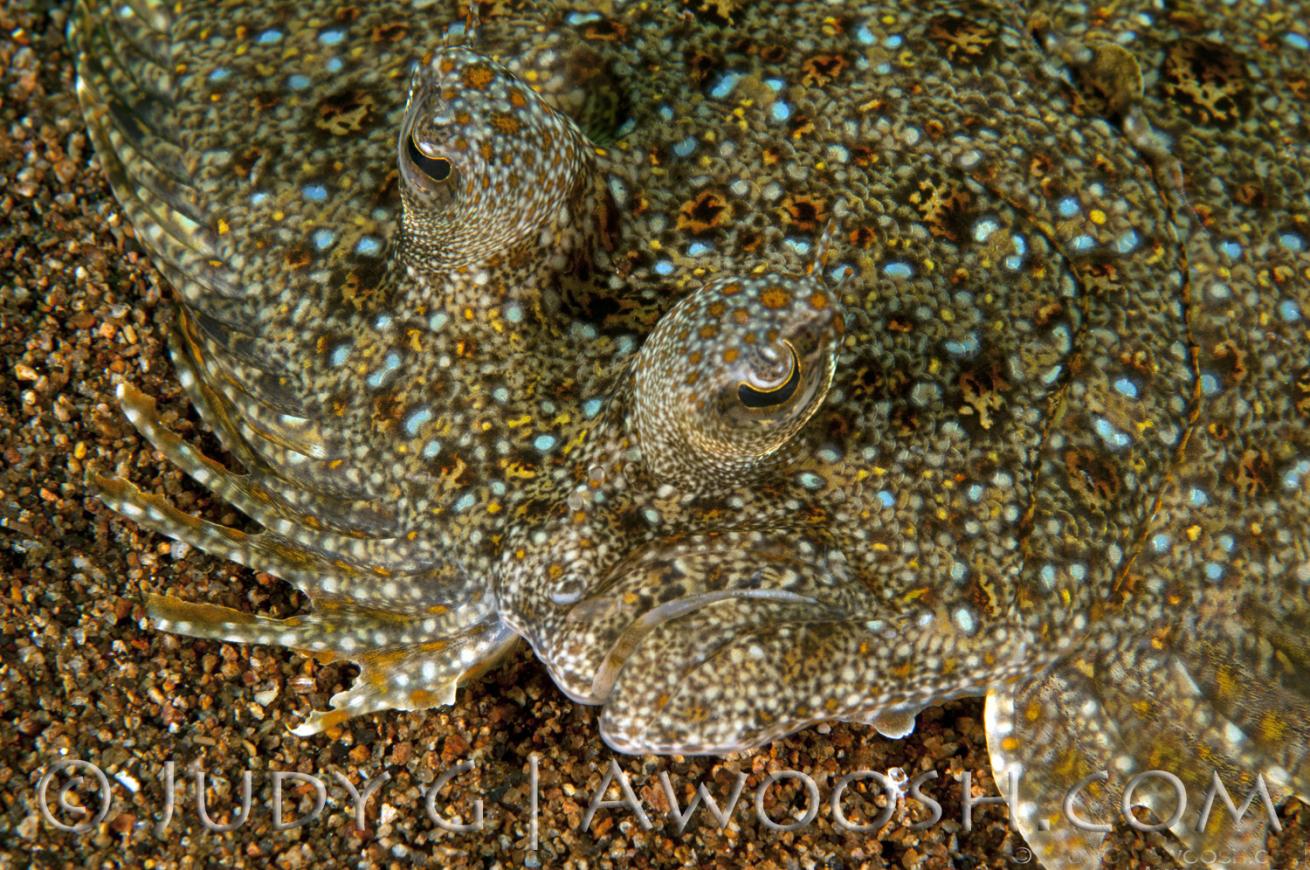
Judy GThis is a fairly common fish, but I share it to demonstrate how incredible some ocean species are at camouflage. If it hadn’t been for a bit of movement as I swam near it, I never would have seen this fish.
The local diving is done from a small fleet of dive boats that the resort operates. Again, these are logically set up and are a comfortable platform from which to dive. Entry is via backroll and re-boarding is done via a ladder. Typically the boats go out for a single-tank dive, and return for refills, refreshments, quick camera recharges and potty breaks. Four boat dives are offered per day, as well as shore (muck) diving. Air and Nitrox fills are available. Dive packages include both local boat-access muck diving and excursions to Apo Island for reef diving. I’d go back in a heartbeat …
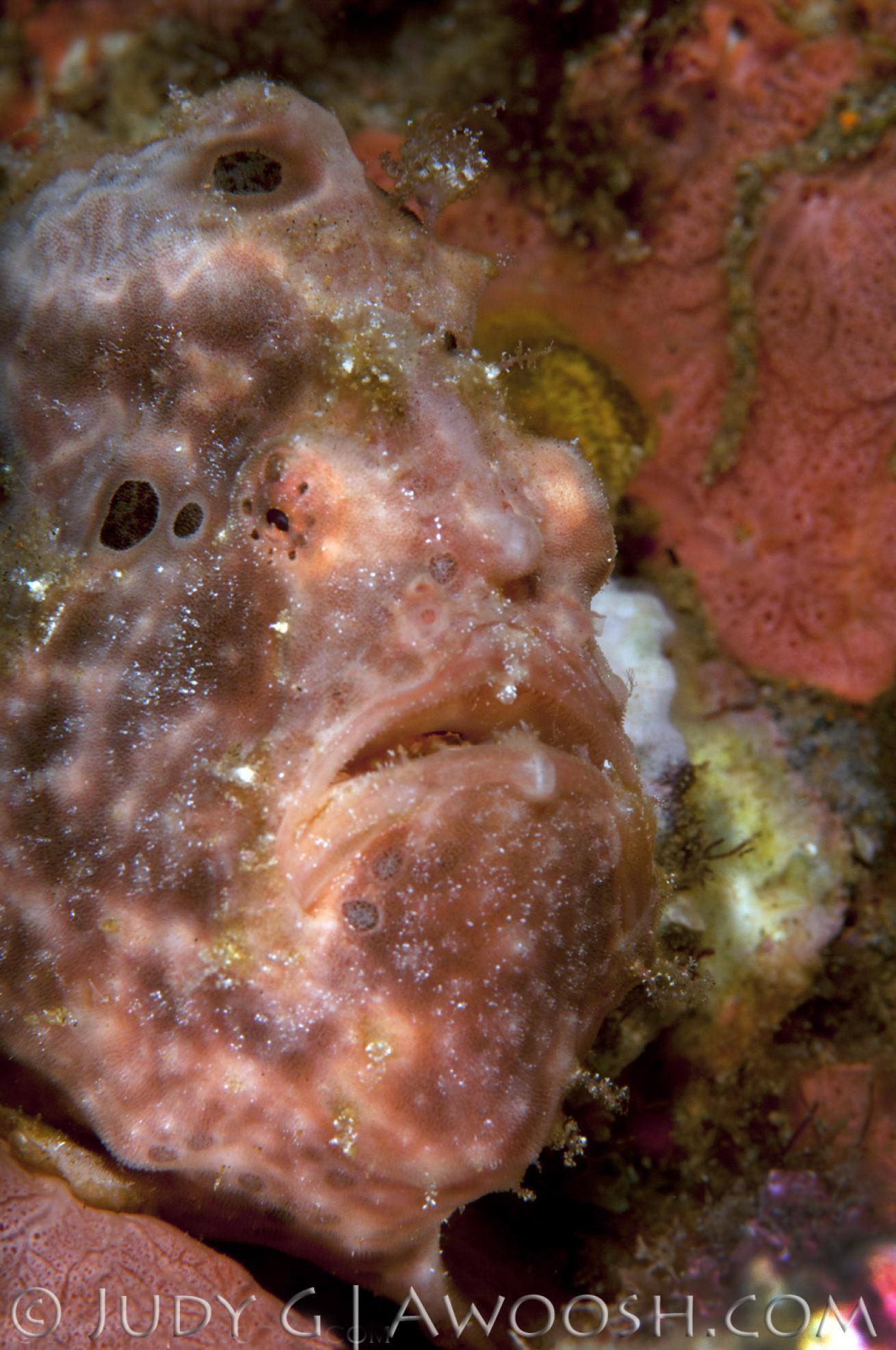
Judy GWe saw several frogfish while we were muck diving at Dumaguete, but this is the first pink one I’ve ever seen!
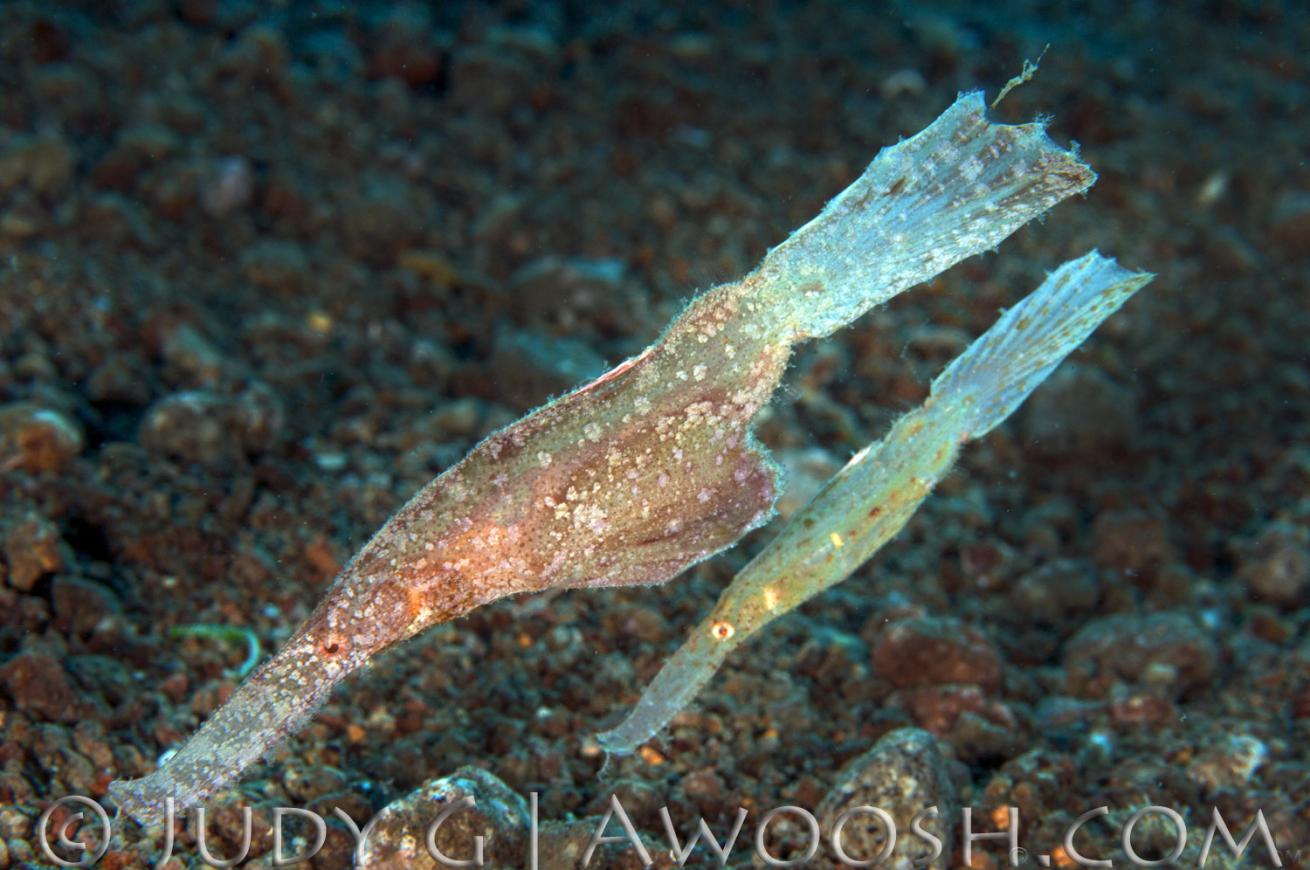
Judy GThese intriguing little fish are also great at camouflage. They look a lot like bits of broken off sea grass, wafting along the bottom. There are several varieties of ghost pipefish — and they are very often spotted in pairs like this.
Our second week was spent aboard the Atlantis Azores — part of the Atlantis group that currently has two dive resorts in the Philippines (Atlantis Puerto Galera being the other). The boat moves to different regions of the Philippines during the year, and so offers several itineraries. The beauty of our schedule was that the liveaboard picked us up and dropped us off at the resort, so transferring dive gear, cameras, baggage, etc., could not have been easier.
The Atlantis Azores is a spacious liveaboard dive vessel. The cabins are all reasonably appointed (each with an en-suite washroom), with the owners’ cabin being quite large and luxe. The main salon/dining area is as roomy as any boat I’ve been on. The food was exceptionally tasty, with meals offered both a la carte and served family style. The dive deck is well laid out with ample storage for each diver. Dive operations were as well organized as at the resort, and dives were lead by experienced dive guides. All dives are done from dinghies, and so involve back roll entry and a ladder to exit the water.
Our seven-day itinerary started with a morning at Oslob to snorkel with the whale sharks — which was the highlight of the trip for me. The story is that historically whale sharks have migrated through this region of the Philippines. Local fishermen used to capture and kill these gentle giants (whale sharks are filter feeders, so are not a threat to humans). At some point they realized that they could make more money by creating opportunities for tourists to swim with the sharks than by fishing them. These days, hundreds of people pay a park fee at Oslob, and then are dropped into the water for an hour or so interface with the sharks. It is a bit of a circus with so many people in the water at one time (and makes getting pleasing pictures challenging as well). The whale sharks are free to come and go, but they have been conditioned by the fishy handouts that the fishermen provide. Some might argue that the feeding of these sharks is changing their behavior (as an example, whale sharks are known to be highly migratory beasts, but these sharks appear to stick around for the free lunch). Personally, I’d rather see sharks conditioned to hand feeding than dead and de-finned …
Our trip then took us as far north as Sumilon Island, then to Cabilao Island, Panglao Island, and then a couple of days at beautiful (but touristy) Balicasag Island before our return to Dumaguete. This itinerary offered a good mix of pretty reef diving and a bit of muck, with the beautiful vertical terrain at Balicasag being the stand out location for reef diving.
I loved my first taste of the Philippines and would strongly recommend this destination. The relative ease of travel, budget-friendly dive options, great muck diving and pretty reefs, beautiful topside scenery, and wonderfully warm and generous Philippine people put this destination high on my all-time favorite dive destinations.
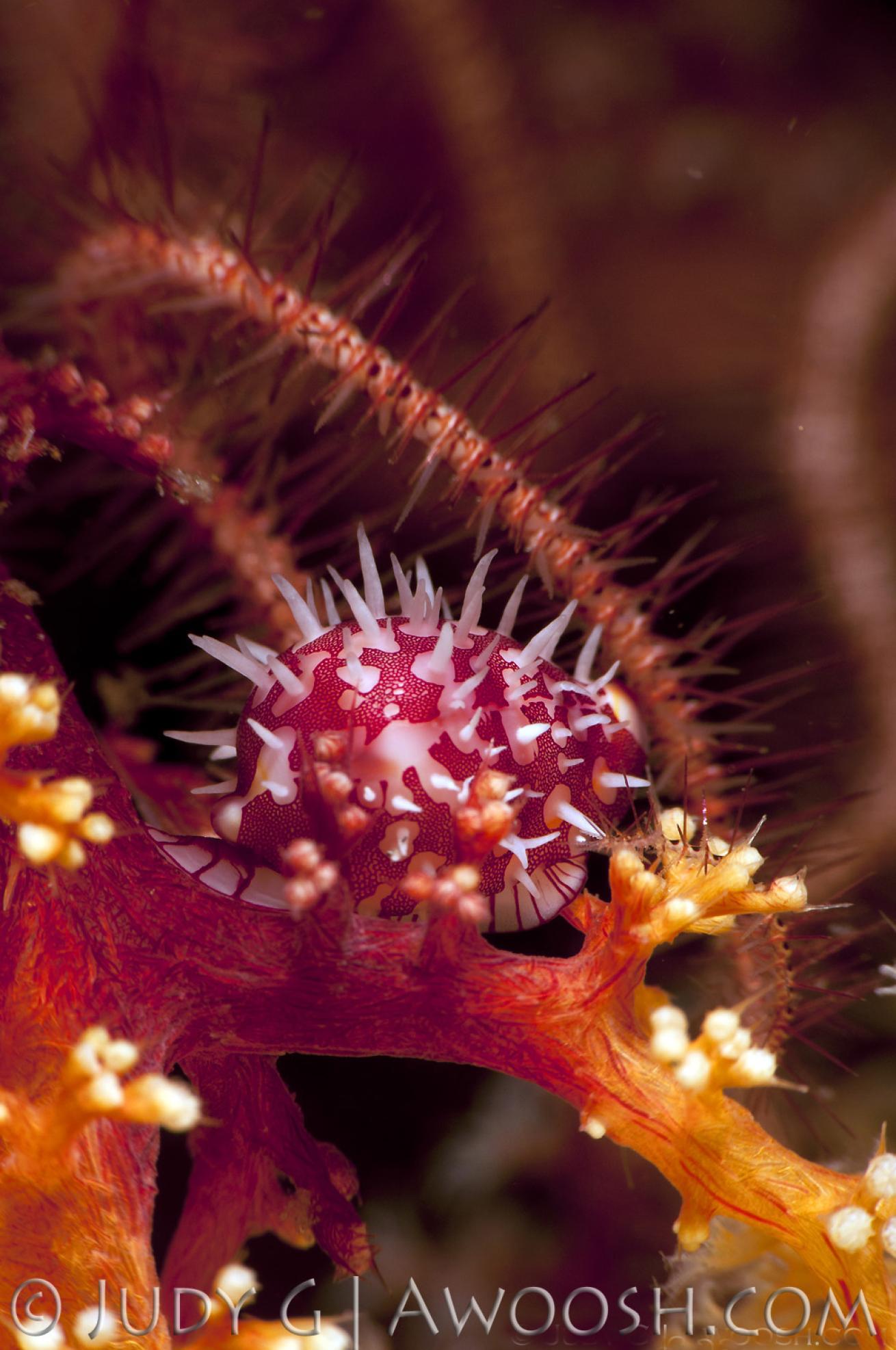
Judy GAnother first for me — and an exciting find. These little beauties are mollusks. This variety inhabits soft corals. At about a half an inch in diameter, and looking a lot like a soft coral polyp, they are not easy to spot.
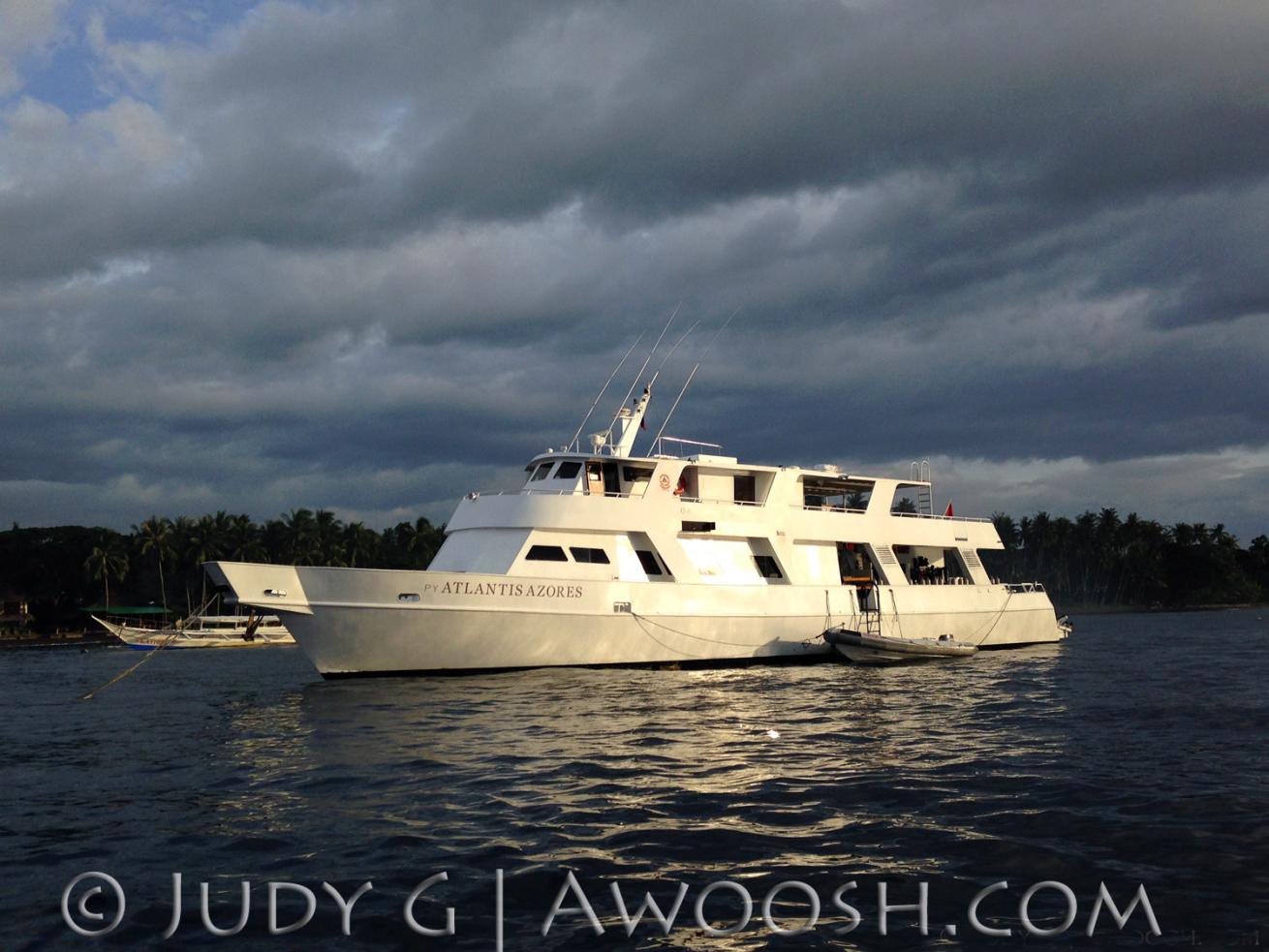
Judy GThis is the Atlantis Azores liveaboard yacht, parked in front of Atlantis Dumaguete Resort. It is 107 feet long, and can carry 16 divers.
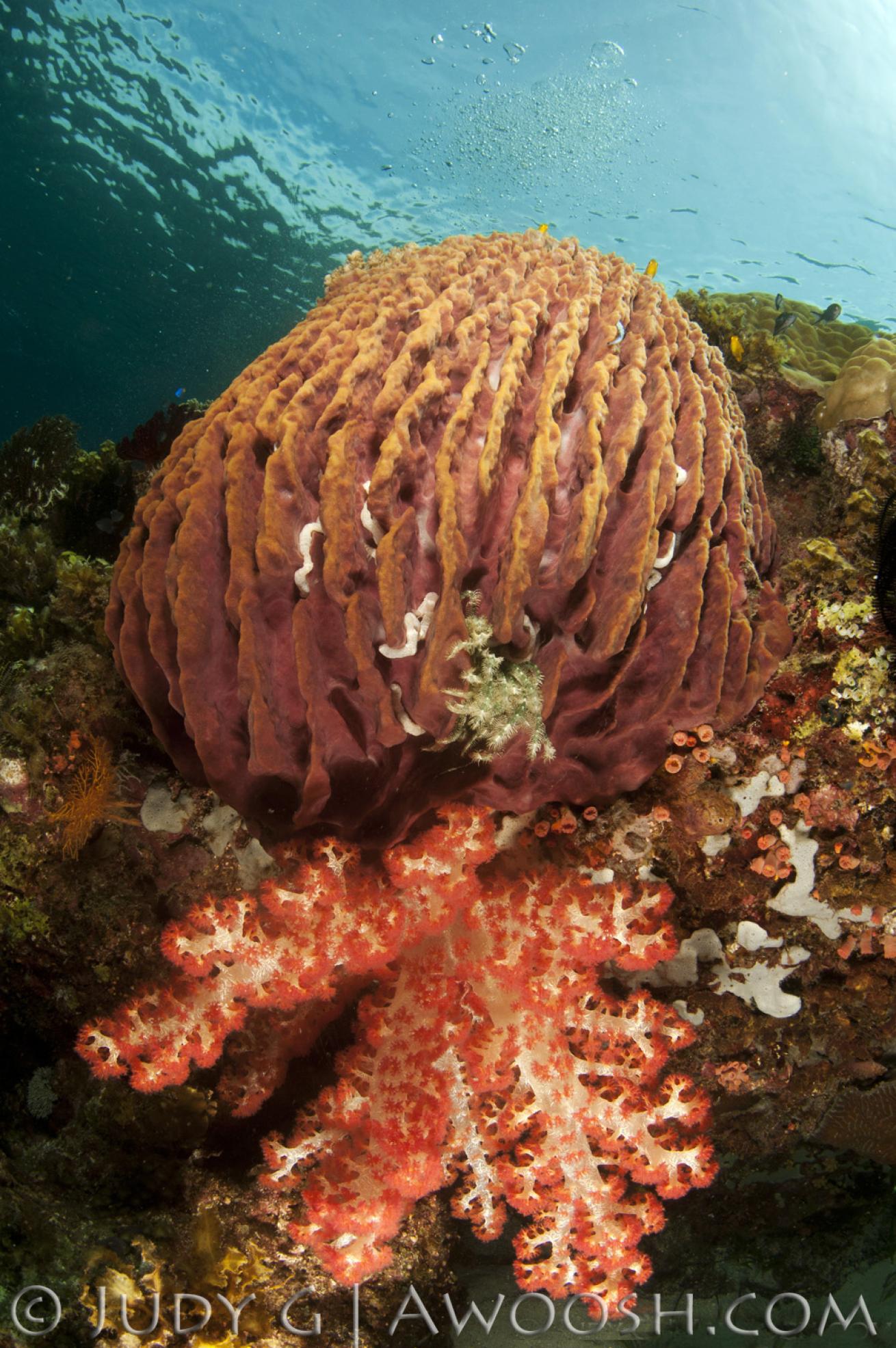
Judy GI did not shoot a lot of wide angle on this trip as there were many interesting smaller creatures to photograph, but this pretty scene caught my eye.
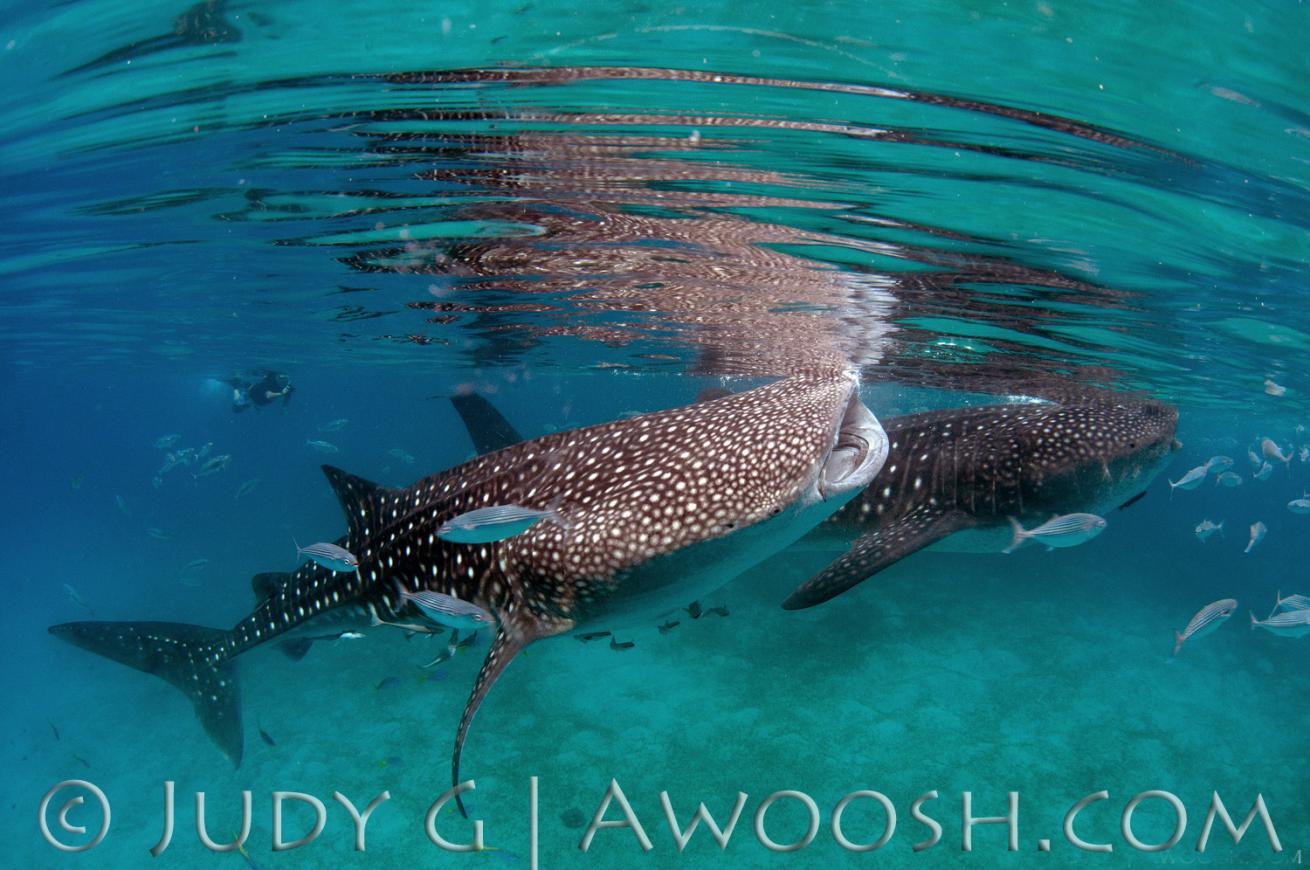
Judy GAs I mentioned in my write up, the highlight of our trip, for me, was the chance to spend an hour or so swimming with these gentle giants. Their behavior became somewhat predictable, as they went from fisherman to fisherman to hoover the handouts, and I was lucky to be able to get this shot of two together without masses of swimmers in the image.
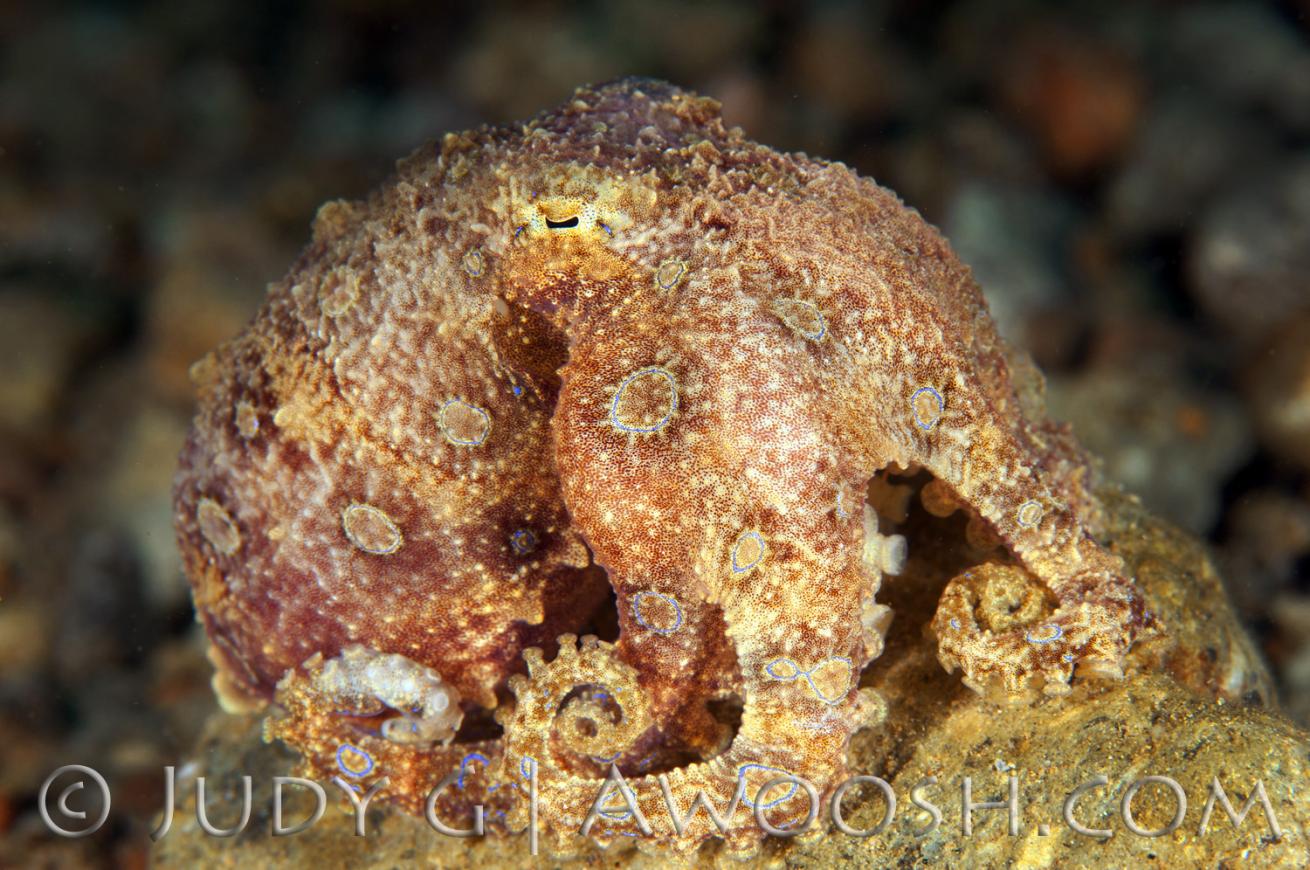
Judy GI have seen this small octopus on a couple of occasions in Indonesia. In Dumaguete, we were seeing several of them, on one dive, on a couple of the sites. This is a highly venomous creature. A bite from its small beak can be fatal.
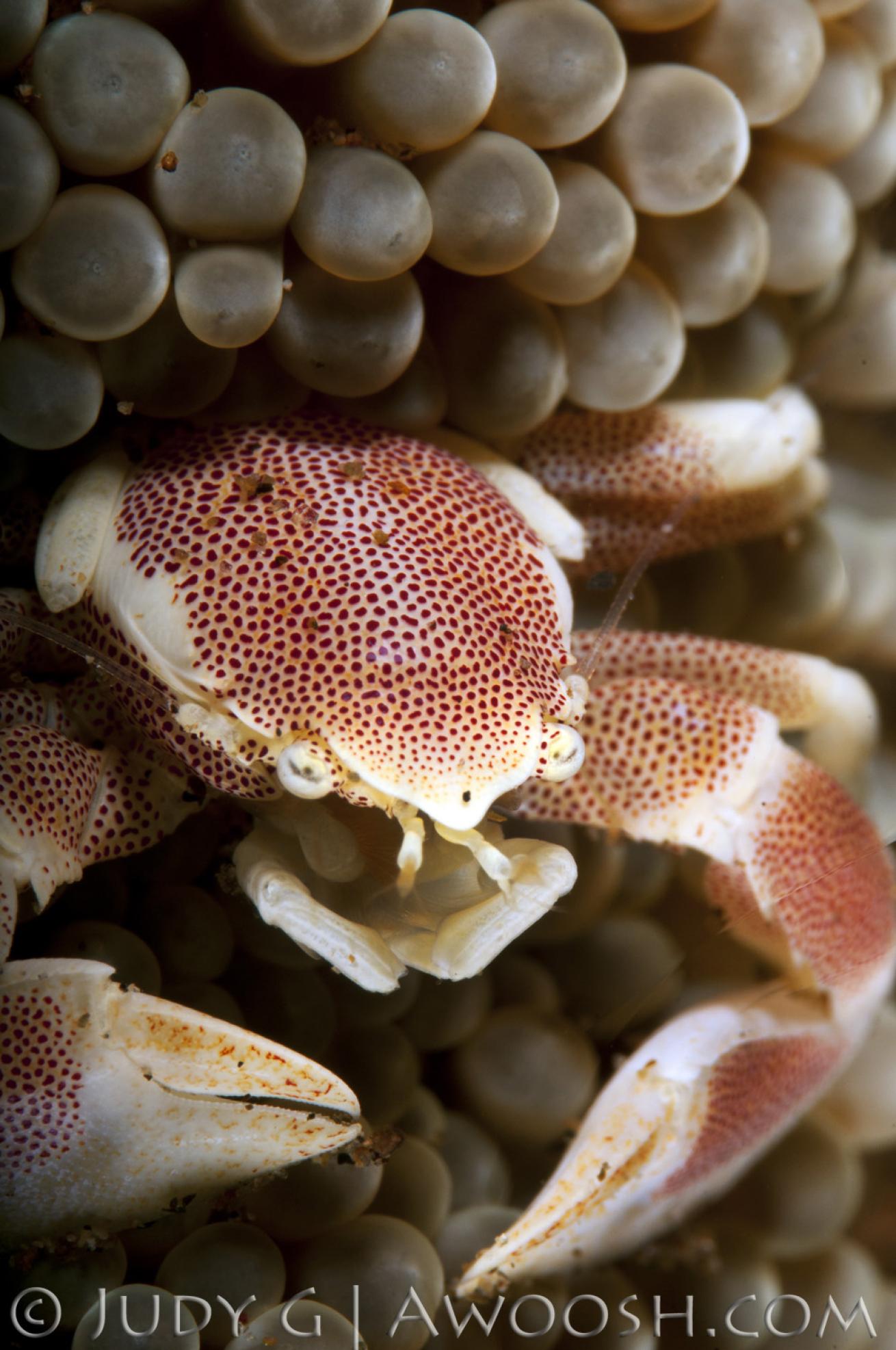
Judy GThese crabs live on carpet anemones, and there is usually a pair of them in residence. They love to burrow down in the tentacles, or scurry to the back side of the anemone, so you have to be fast with the camera.
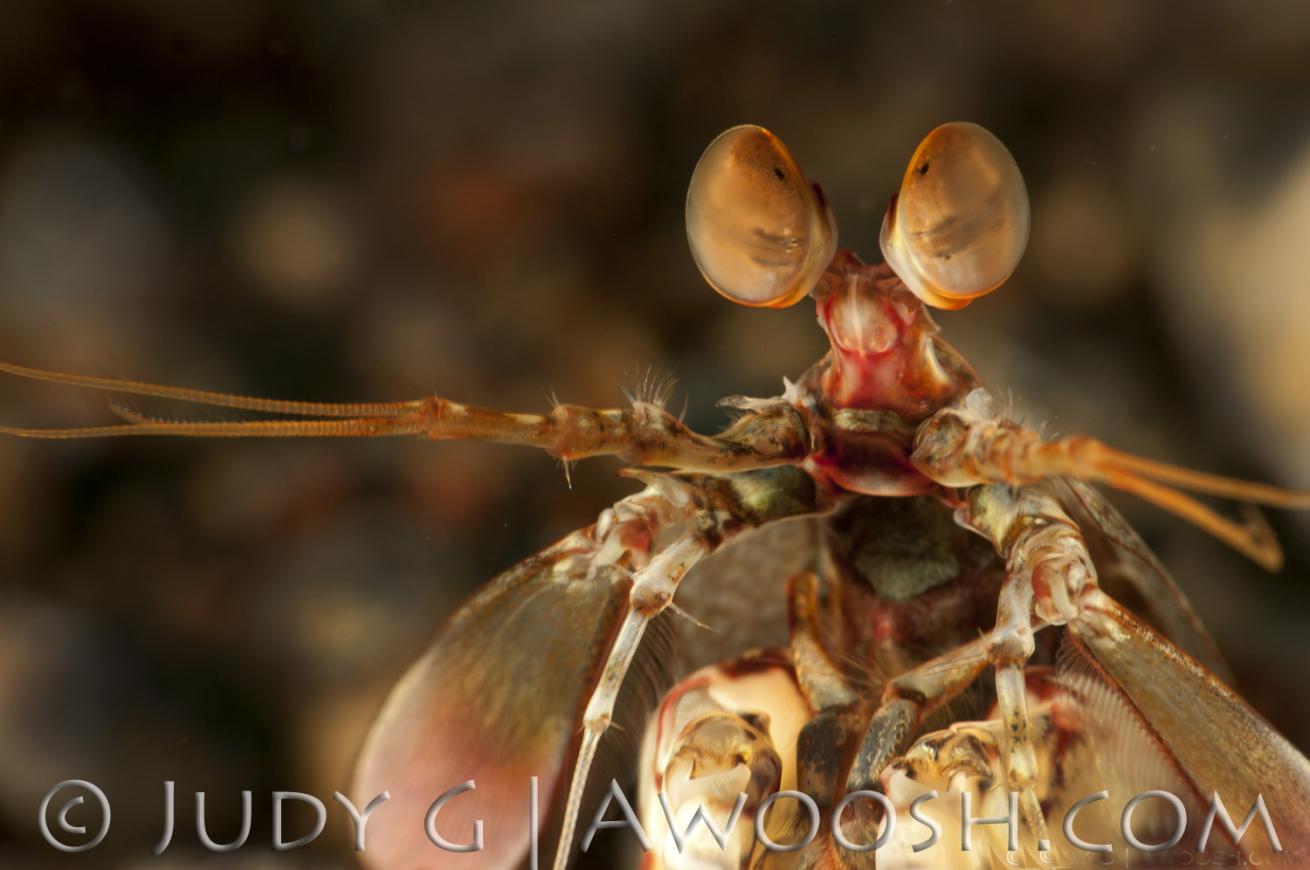
Judy GAnother first sighting for me — this is either a Pink-Eared or Short Beak mantis shrimp — I am not able to positively identify it from this image. Mantis Shrimps are otherworldly creatures: weird eyes on stalks, bug-like bodies, and some of them have lightening fast smashing claws. When I went to my identification book to try to figure out what this one was, I saw two others — called ‘Painful Mantis’ and ‘Wicked Mantis’ — no doubt because some curious observer or photographer took a hard hit from one of these strange crustaceans ;)
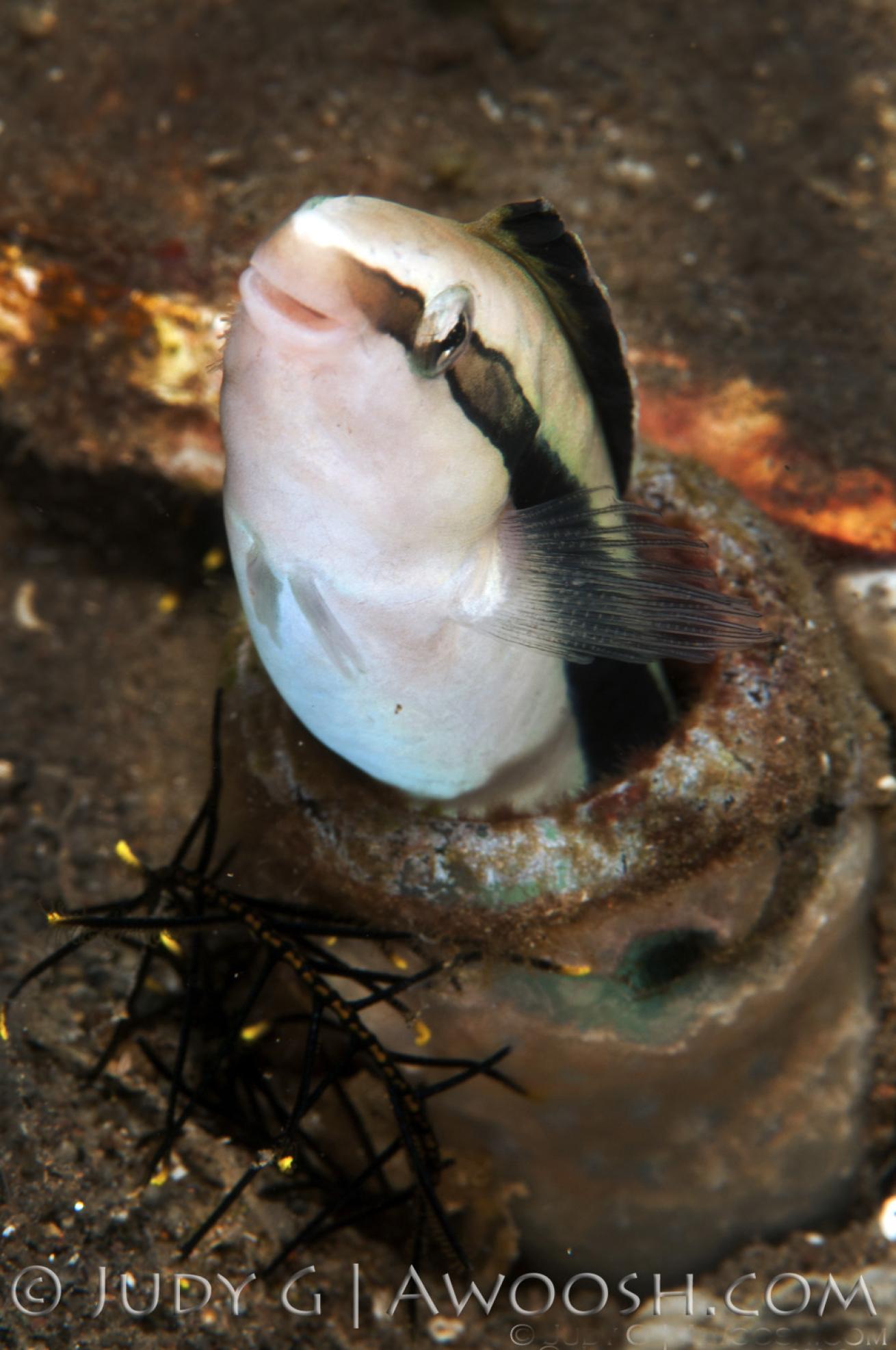
Judy GThere are hundreds of varieties of Blennies in the Tropical Pacific. I am fairly sure this one is a False Cleanerfish. These funny-faced little fish like to live in holes (where they tend to recede when divers approach), and a discarded bottle apparently makes a great den.
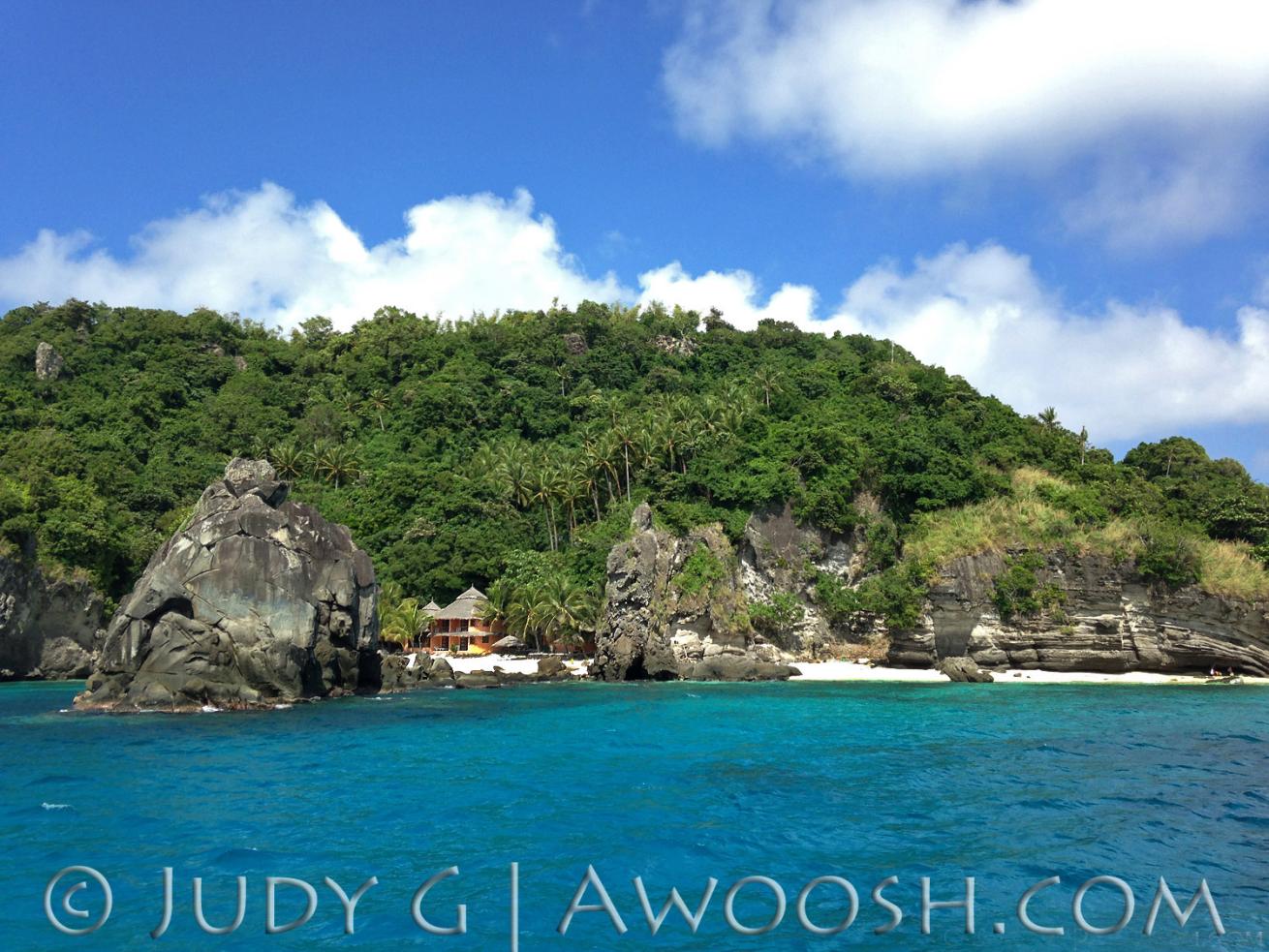
Judy GApo Island is about an hour boat ride from Atlantis Dumaguete Resort. It is a lush, lovely place with some small fishing villages and a few small resorts. The reef diving here was very nice.
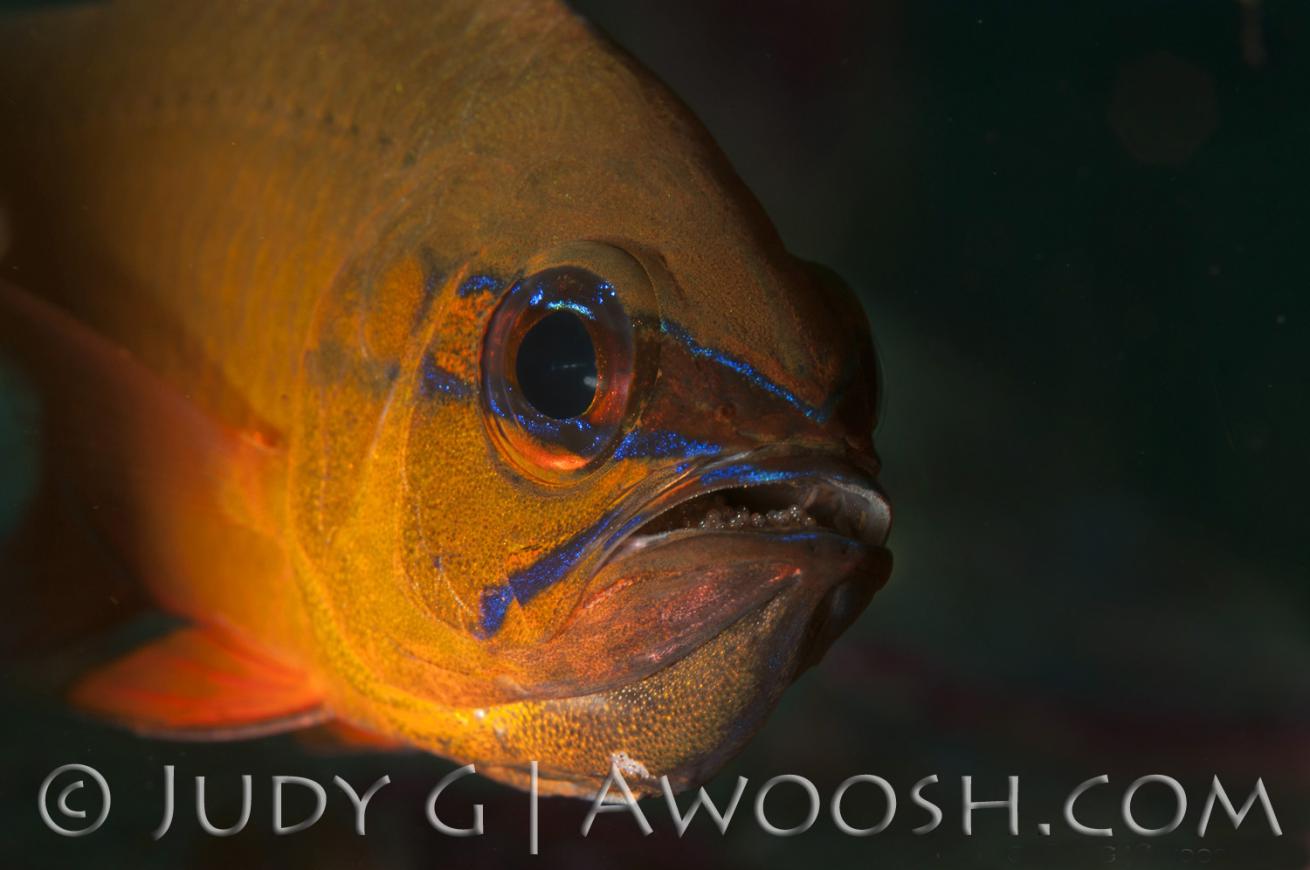
Judy GAnd another first for me — finding a ring-tailed male cardinalfish, with eggs. The males of this species mouth brood the eggs until they hatch, and apparently don’t eat for the duration of the gestation.
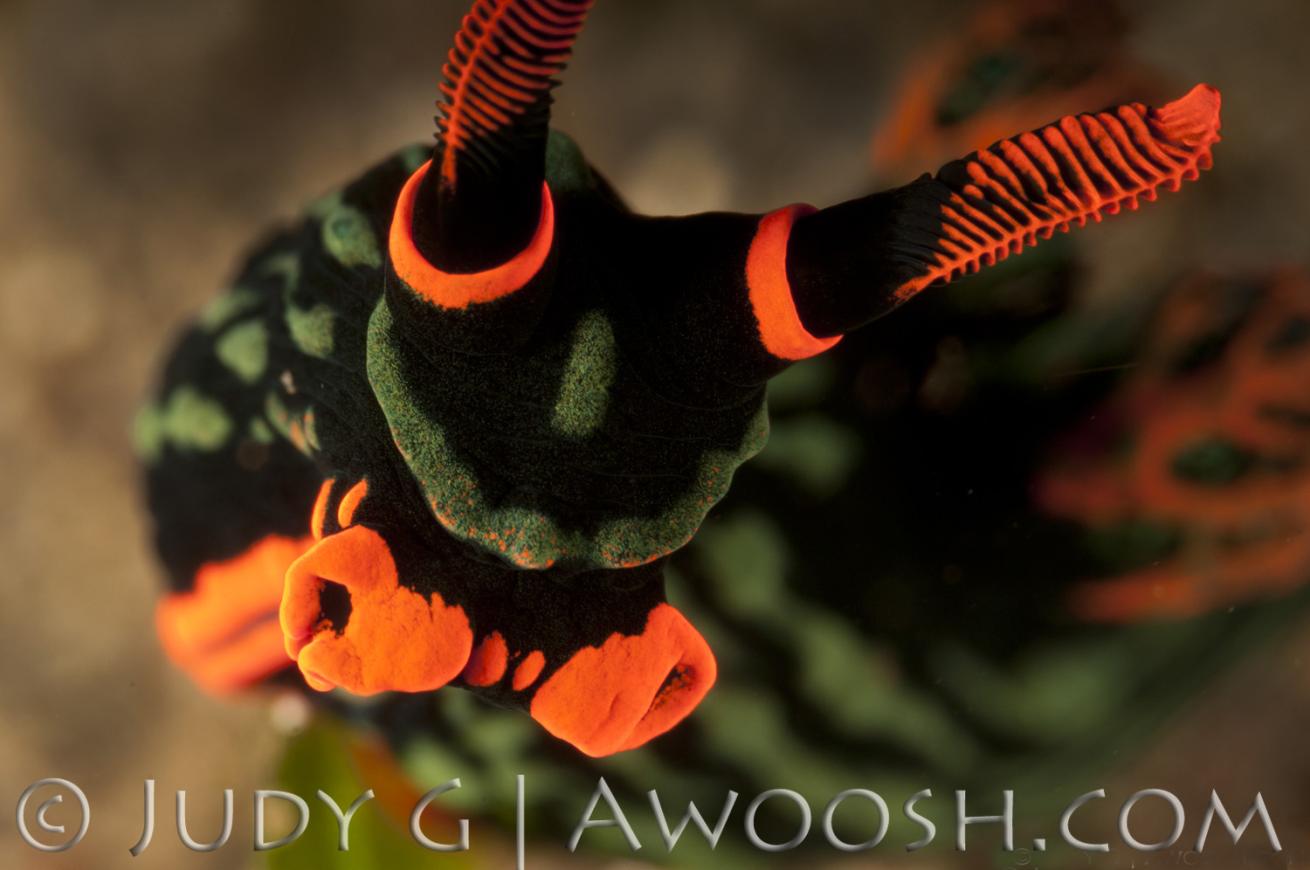
Judy GThis is quite a common nudibranch in the Tropical Pacific, and we saw several on our dives in the Philippines. Unlike some nudibranchs, these are not difficult to spot — they are quite large (several inches long) and the bright orange margins on them make them pop on the reef.
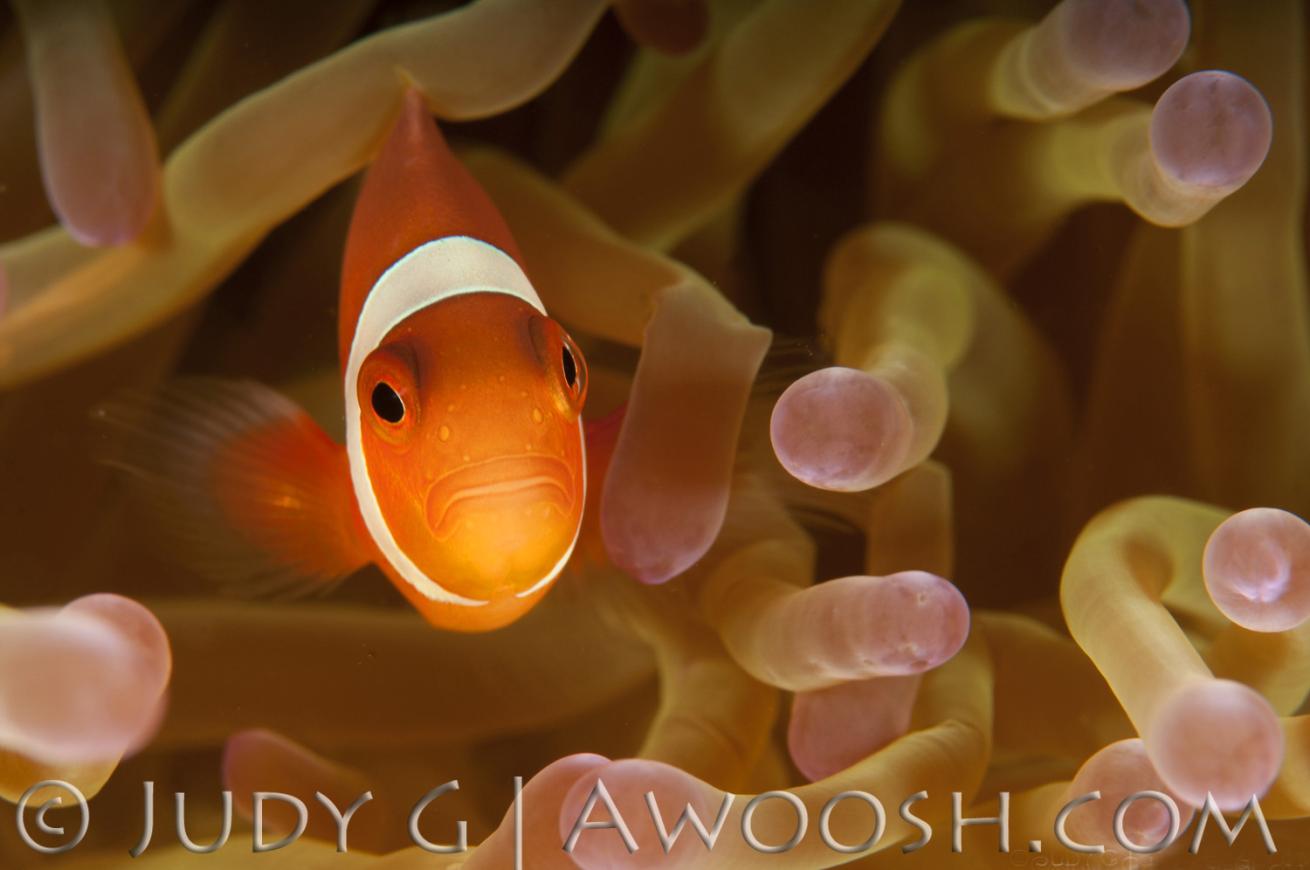
Judy GWe saw several varieties of Anemonefish in the Philippines. The Tomato variety seems to be less common, and is super cute when young.
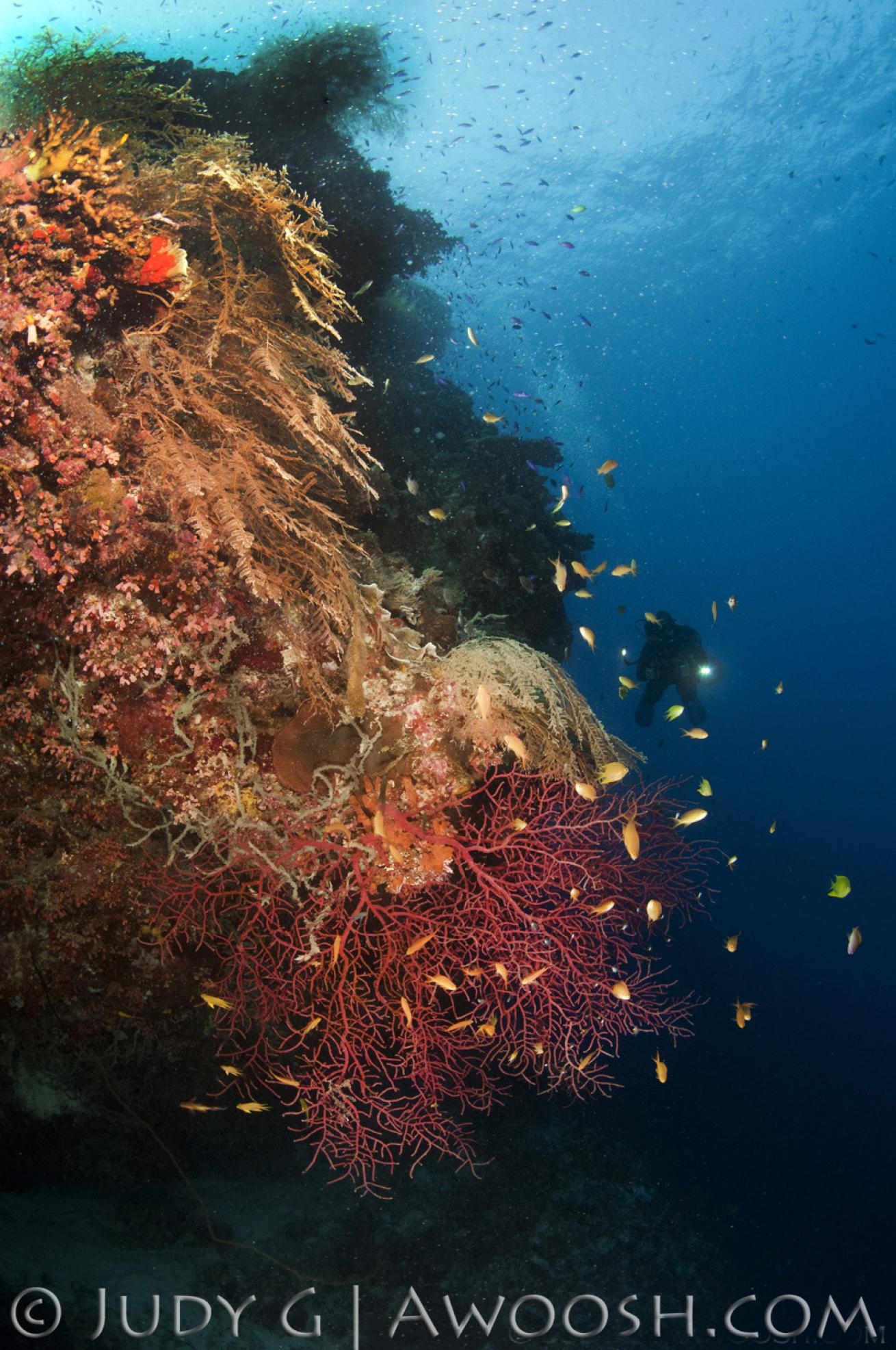
Judy GI captured this image at Balicasag Island — which is home to some beautiful reefs and some nice steep wall diving.
More of Judy G's Underwater Adventures:
Meet the Woman Behind the Lens | Oh, Baby! Juvenile Critters | How to Find Nemo

